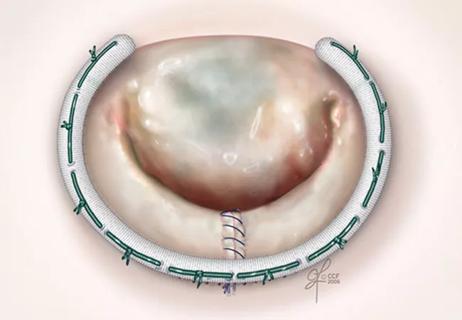A call for surgical guidelines to adopt sex-specific thresholds of LV size and function

By the time women with degenerative mitral regurgitation (MR) meet recommended thresholds for surgical repair, they are more likely than men to have more frequent and severe symptoms, atrial fibrillation and a higher left ventricular end-systolic diameter indexed to body surface area (LVESDi). Additionally, after surgery, they have worse long-term mortality than their male counterparts.
Advertisement
Cleveland Clinic is a non-profit academic medical center. Advertising on our site helps support our mission. We do not endorse non-Cleveland Clinic products or services. Policy
So found a retrospective cohort study of more than 4,500 patients who underwent isolated mitral valve (MV) repair for degenerative MR at Cleveland Clinic, recently published in the Journal of the American College of Cardiology (2024;83[2]:303-312). The authors call for consideration of revising surgical guidelines with sex-specific thresholds so that women may be recommended for MV repair surgery earlier.
“Although women and men had similar absolute systolic dimensions at the time of surgery, when indexed to body surface area, women’s dimensions were significantly larger,” says corresponding author Leslie Cho, MD, Director of Cleveland Clinic’s Women’s Cardiovascular Center. “It’s no surprise that women’s outcomes after mitral valve repair are less good than men’s since women are being operated on with more advanced disease.”
Current American College of Cardiology (ACC)/American Heart Association (AHA) and European Society of Cardiology guidelines have uniform thresholds related to cardiac size and function when determining candidacy for MV repair. Current ACC/AHA Class I recommendations for surgery for severe MR are symptomatic disease, an LVESD of at least 4.0 cm and an LV ejection fraction of less than 60%.
However, notes Dr. Cho, it is well recognized that there are important differences between men and women with severe MR. “At similar levels of clinical severity, women tend to have smaller cardiac dimensions than men, so they tend to be sicker by the time they meet surgical thresholds,” she says.
Advertisement
Although MV prolapse is more common in women than men in developed countries, women are often less represented in observational studies of MV interventions. This study was designed to compare long-term all-cause mortality between men and women following MV repair for isolated degenerative MR with respect to baseline measures of LV size and function.
All patients underwent isolated MV repair for degenerative MR at Cleveland Clinic between 1994 and 2016. Of 4,589 patients analyzed, 40% (n = 1,825) were women and 60% (n = 2,764) were men. Over median follow-up of 7.2 years, 344 deaths (7.5%) occurred across the cohort.
At baseline, women and men were of similar age, had similar levels of MR and tricuspid regurgitation, had a similar ejection fraction (mean of 59%) and had similar LVESD measures. However, the following key significant differences were found:
Important differences in outcomes were also identified:
Advertisement
With higher ejection fractions and smaller cardiac sizes than men at similar levels of disease severity, women with MR are less likely to meet thresholds for MV repair under current guidelines.
“Women were found to have higher rates of long-term mortality for the same preoperative ventricular dimensions adjusted to body size as men, and for the same ejection fractions,” Dr. Cho observes.
She emphasizes that the study findings are strong, given the large cohort, the long follow-up period and the cohort’s uniformity in that all patients underwent isolated MV repair for degenerative MR.
“When a woman (or a man) is found to have severe mitral regurgitation on an echocardiogram, it is time to consult a surgeon,” notes study co-author A. Marc Gillinov, MD, Chair of Thoracic and Cardiovascular Surgery at Cleveland Clinic. “Waiting to fix the valve is detrimental, particularly for women. With our contemporary mitral valve repair rate of 99.8% and a risk below 0.05%, a simple operation to repair the mitral valve is clearly the patient’s best option.”
Dr. Gillinov continues: “We hope our study will prompt guideline-setting societies to consider adopting sex-specific ejection fraction and LVESDi thresholds to help determine candidacy for surgical repair to treat mitral regurgitation. The negative consequences of waiting to meet currently recommended thresholds for left ventricular dimensions and function are significantly greater for women than for men.”
“There is increasing evidence that one size does not fit all in optimally timing valve intervention, and that sex and age may modify cardiac remodeling, especially in valve regurgitation,” adds Brian Griffin, MD, Section Head of Cardiovascular Imaging, who was not involved in the study. “This paper comes on the heels of prior evidence from our group that women with aortic regurgitation also may benefit from intervention at lower left ventricular size than men. Awareness of these sex differences is important in ensuring the best possible long-term outcomes for patients with these common and very treatable valve lesions.”
Advertisement
Advertisement

Two surgeons share insights on weighing considerations across the lifespan

An overview of growth in robot-assisted surgery, impressive re-repair success rates and more

Judicious application yields a 99.7% repair rate and 0.04% mortality

Cleveland Clinic series supports re-repair as a favored option regardless of failure timing

Cleveland Clinic series shows re-repair is feasible with excellent midterm results

The cultural and technical factors promoting repair durability and a mortality-free stretch of 4,000+ cases

Cleveland Clinic screening tool yields results comparable to those with sternotomy

Tailored valve interventions prove effective for LVOTO without significant septal hypertrophy